
Dive The SS Rangoon (www.DiveSriLanka.com)
The ship on the sandy plains
Unawatuna
By Dharshana Jayawardena.
Depth:32 Meters
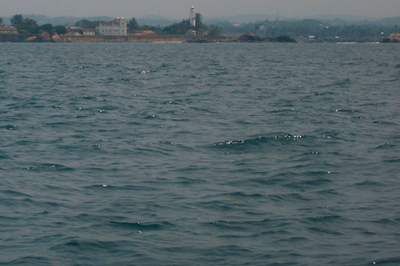
The SS Rangoon is located right in front of the historic Galle Fort. The fort is the finest surviving example of a Dutch Fort in the whole world.
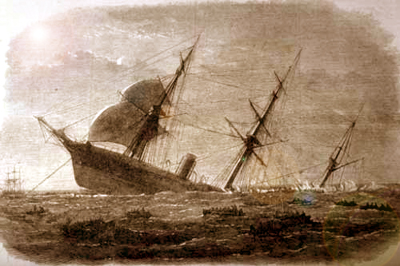
The Rangoon slips beneath the waves around midnight as the survivors and villagers in canoes pull away
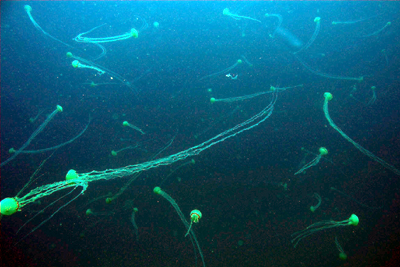
Some of the many thousands of Jelly Fish (Chrysaora) that visited the
SS Rangoon on this day. [Picture: Fredrik from Germany]
The captain cuts the engine and our dive boat glides to a silent stop.
Miles away, right in front of us, we see the towering walls of the historic
Galle fort. It seems that the Rangoon had sunk right in front of the harbor
mouth. Eager to explore this historic ship wreck that has been lying on
the ocean bottom for a hundred years, we hastily gear up and plunge into
the warm tropical water.
In an instance an amazing sight overwhelms us with its sheer beauty and
magnitude. Pulsating all over the water at a depth of about 5 meters are
hundreds of thousands of glistening Jelly Fish with long trailing tendrils.
It takes us a few seconds to remember that we shouldn't be holding
our breath and also that we should be exploring the wreck waiting for us
below. Gradually we sink to the bottom careful to avoid the swarming Jelly Fish.
At 25 meters, a dark form takes shape below. It is the SS Rangoon,
standing
proudly upright in the beautiful sandy bottom. We seem to have
cleared
the dense layer of Jelly Fish and entered clear water with 20m+
viz. At 32
we touch bottom and behold the dark beast in front of us. The
front
reminds us of an ancient Viking ship. But this is hardly that.
The SS Rangoon
is a 60M long 1800 Ton heavy sailing/steamer built by
1863. Captained by Scottowe, on his last voyage this steam powered
thrust out 450 BHP on her routine trips
from the Colombo to the
colonies in Australia.
Even at 30M there is a lot of light.
The immaculate white sand seem to
reflect light in all directions on this
beautiful sunny day. A large school of
Blue Striped Snappers form a
beautiful yellow cloud around the wreck. Amongst them mingle a smaller
school of Sri Lankan and Javanese Rabbitfish, Grey Snappers and the
darting Blue Fin Trevally. We swim
across the length of the wreck peering
into the crevices and seeing
numerous red Soldierfish and the millions of
little Glassfishs. The masts
of the ship are still intact and upright.
Occasionally we lookup at the
magnificent spectacle above. Like a million
of comets painting a night sky
heralding a biblical event, the Jelly Fish are
still there, gently pulsating
and swimming in all direction. It takes some
effort to tear ones eyes from
this vision of beauty and focus back on the
wreck. We are now swimming
over a lesser defined part of the wreck.
Sections have broken away and
almost seamlessly merge into the fine
sand except for the stark contrast
of black against the white. It is striking
to think that the ship looks so
clean. Like some museum show piece.
Indeed, a museum is where this
fine wreck deserves to be.
Amidst this beauty it is easy to forego of the sense of time. But it is now the time
to ascend. We have stayed at this depth close to 25 minutes and
approaching the decompression limits. A wall of Jelly Fish await us as
we ascend. Like navigating a tricky maze, the divers crisscross
the water avoiding the fine tendrils of the Jelly Fish and also wondering whether this was really an "Open Water" dive. Finally, not without
some difficulty,
and light stings, we clear the layer of dense Jelly Fish
and pause for the safety stop.
It is over. What a fantastic dive.
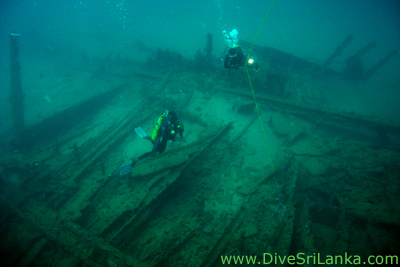
Two divers descend to the ship along an anchor line.
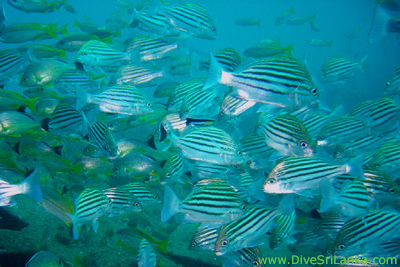
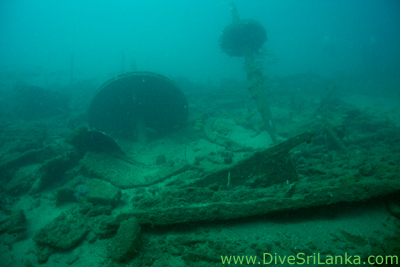
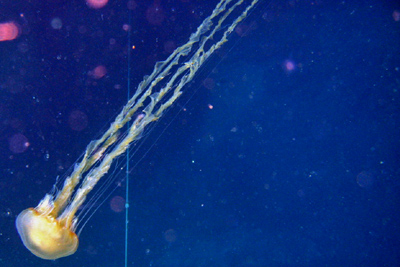


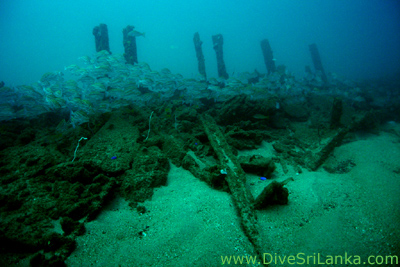
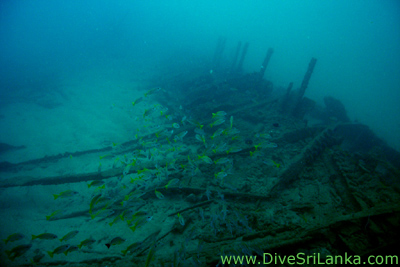


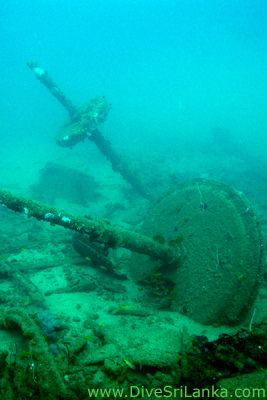
Picture of Jellyfish by Fredrik from Germany
< Back to Unawatuna dive sites